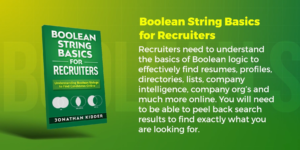
Finding the best candidates in an ocean of choices can be likened to finding a needle in a haystack. Even with an assortment of filtering options, narrowing down a list to only include the best of the best is difficult and time consuming. Fortunately, Boolean search string tools can make the task less challenging for recruiters and is easily incorporated into searches on LinkedIn, various job portals, and on Google.
Using Boolean Strings
By using the basic Boolean search operators and modifiers, you’ll be able to incorporate specific keywords into your searches. Applying Boolean search strings will take some practice, but once you learn the process, you’ll have the ability to compile well-defined lists of candidates, whether searching for specific job titles, targeting social media sites, or procuring resumes according to experience.
AND
Using the “and” operator, you can broaden your search by adding multiple keywords that apply to the individual you’re searching for. Note Google no longer requires the AND keyword in searches instead just include a space. The search string would look like this:
- content writer AND editor
- graphic designer AND photographer
- customer service AND tech support
This operator will help you narrow down results to individuals who match your specific criteria. What’s more, you’re probably already using this operator! Just by putting a space between keywords, you’re applying the “and” operator to your searches in LinkedIn and Google. So, simply type “content writer editor” or “customer service tech support” and you’ll only get results that match all keywords in your string.
OR
If you have specific alternatives for a role or skill in your search, the “OR” operator will help you get the right results. For instance, if you are looking for a content writer who is also either a content creator or content developer, your search query would look like:
- content AND writer OR creator OR developer
- graphic designer AND Lightroom OR Light Room
- customer service AND tech support OR technical support
As you can see in the last two examples in the above list, the “or” operator can also be used to help you find candidates when multiple spellings of a term may be used, like in the case of “Lightroom” or “Light Room” or “tech support” vs “technical support.”
If you want to use the “or” operator, use the pipe character (|) on Google, LinkedIn, Bing, and Monster instead of spelling out “or” in your search.
NOT
Using the “not” operator will help you further limit your search results by ruling out specific terms. For instance, if you want a content writer and/or editor, but not a content developer, you can use the “not” operator to remove the keywords or skills you do not want to find.
- content AND writer OR editor NOT developer
Instead of typing “not” in your searches, use the hyphen on both Google and LinkedIn, making your search query look like the above.
Other Search Modifiers
The and, or, and not operators are the easiest way to start using Boolean searches and they are powerful on their own, but additional modifiers will help you get even more specific when looking for candidates.
Add Emphasis: Put parenthesis around words to give priority to them. For instance, if you want a content writer who works in tech, but isn’t a freelancer, your search would look like: “content AND (creator OR editor) AND (technology or tech) -freelancer.
Exact Matches: Tired of finding irrelevant or half matches to your searches? Try using quotes around terms to find the exact phrase in your search.
Wild Card: Use the asterisk (*) to add a wild card to your search. This is helpful for finding all variants of a keyword without listing them out. For instance, you could use this for “tec* writer” to find: tech writer, technology writer, technical writer, etc.
As you can see, using Boolean search strings is easy once you know the terms to use, but they can make a major impact in the quality of the results you’re getting. So, if you’re not already using Boolean strings in your work as a recruiter, it’s time to test it out for yourself. Let me know in the comments what you’re going to experiment with first!
Here’s some Advanced Boolean String examples created by Jung Kim:
- site:gdg.community.dev/u/ data engineering
- site:com/author “software developer|engineer” “rust”
- “* * developer|engineer” (c rust OR c++ rust) inurl:resume.pdf
- “* * developer|engineer” (c rust OR c++ rust) inurl:resume -inurl:pdf
- site:stackoverflow.com/cv“* * developer|engineer” (c rust OR c++ rust)
- site:com/cv OR site:com/resume “developer|engineer” (c rust OR c++ rust) -stackoverflow
- site:”-*-” resume “developer|engineer” (c rust OR c++ rust) -job|jobs “gmail.com”
- site:github.com“rust” “Users who have contributed to this file”
- site:gitcoin.co/profile
- site:com/profile “software developer|engineer” nodejs|reactjs
- related:github.io.resume “software developer|engineer” “gmail.com” -”ask hn”
- “Amazon Web Services License AWS *” architect
- “software developer|engineer” inurl:”meet*team”
- “prior to joining * *” “software developer|engineer”
- inurl:resume.resume “software developer|engineer” “gmail.com”
- site:hackerrank.com/profile (java OR ruby OR python OR c++)
- inurl:wp-content/uploads github “gmail.com” intitle:resume OR inurl:resume react redux
- site:news.ycombinator.com/user?id
I recommend checking out my Boolean Basics Book for recruiters available on amazon:

Recommended Reading:
Review of Very Fast Extension LinkedIn Tool
The Best Email Finder Google Chrome Extensions for Recruiters
Essential Skills Every New Talent Sourcer Needs to Know
- AI Search Will Transform Talent Sourcing Forever - January 10, 2025
- Build an AI Sourcing Assistant using ChatGPT 4 - January 10, 2025
- Top Recruiting Leaders to Follow in 2025 - January 8, 2025

Hello Jonathan, I wanted to know if this would provide Boolean string example of what I need for certain position and locations?
The “dissertation help near me” keyword targets local dissertation assistance services.